

Better Luck This TimeJuly 16, 2012
Everyone was elated and relieved when the temperature observatory was successfully installed on Monday evening, completing one of the main objectives of JFAST. In about a week's time of Expedition 343T ('T' for technical) we were able to drill the borehole to 855 meters below seafloor and install the temperature sensors across the plate boundary - something that we could not accomplish in over 50 days of operation a few months ago.
"Everything in life is luck"
Donald Trump
"In my experience, there's no such thing as luck"
Obi-Wan Kenobi, in Star Wars by George Lucas.
There are many steps in the deployment of the observatory, such as preparation of the underwater camera system, running the long pipe to the ocean floor, setting the wellhead, borehole re-entries, underwater instrument releases, borehole drilling, casing installation, temperature instrument programming. During the original expedition last April and May, it seemed at almost every step of the way there was some problem or delay. Also there were many concerns about operations in nearly 7000 meters of water, for which Chikyu and other IODP platforms had no experience. This time in July, things were quite different and each procedure went surprisingly smoothly. The reasons are better weather, gained technical experience from the previous attempts, and a lot of good luck.
"Luck can only get you so far"
Hermione Granger, in Harry Potter and the Half-Blood Prince by J. K. Rowling.
"The winds and waves are always on the side of the ablest navigators"
Edward Gibbon
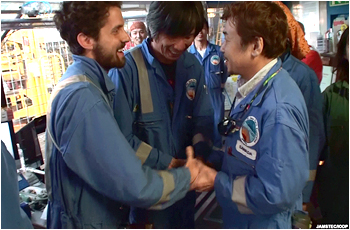
Experience helps. Detailed knowledge of the actual drilling conditions and instrument performance, which are gained from experience, contribute immensely to success. Actually, CDEX engineers know this and told me so last year. At the time, they felt that all the technical challenges of the project could be met, it was just a matter of how many tries it would take and if there was enough time. We were very fortunate on this project that additional expedition days were provided so that we had the opportunity to try again. Also, it is a great credit to the drilling engineers and planning staff at CDEX that they were able to solve the many problems. Finally, luck often swings the balance between failure and success and we got lucky this time (I am getting more superstitious for these kinds of things).
"Those who have succeeded at anything and don't mention luck are kidding themselves"
Larry King
The deployment of the temperature sensors has been an exciting technical accomplishment, but the real scientific results come when we see the recorded data. The next challenge will be in several months when we try to extract the instrument string from the borehole, using a remotely operated vehicle (ROV) in the very deep water. These data should help us understand the huge amount of slip that occurred in the 2011 Tohoku earthquake.
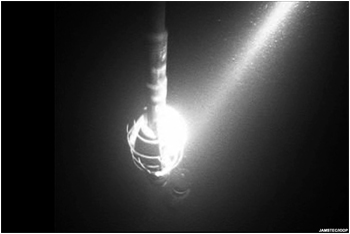
Release of the instrument string from the drill pipe, which was the final step of the temperature observatory installation at 18:15 on July 16 (photo by Patrick Fulton).
More photos from the expedition at
http://www.jamstec.go.jp/chikyu/e/exp343/gallery.html


Record StartApril 24, 2012
Three weeks into the expedition and we were still waiting for the drilling to begin. There had been several false starts during the last two weeks and everyone was getting anxious about the delays. April 22 was a Sunday so there were fewer work activities as the science party relaxed on the weekend. It was also my birthday. I was completely surprised when the scheduled afternoon coffee break turned out to be a birthday party for me.
A lot of effort had gone into decorating the lounge for the party. I’m sure people had more fun creating all the elaborate designs, than the actual party itself. That’s fine with me since I favor any reason to have some fun. Among the decorations, there was a megathrust/sea cucumber/methane molecule/catfish sculpture, a big rainbow poster signed by everyone, leis made of paper flowers, and lots of balloons with written messages. I especially liked the balloon which promised a birthday present of ‘Data’.
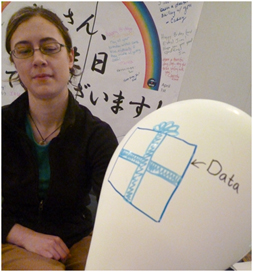
Christine Regalla with the ‘Data’ balloon from the birthday party.
The ship’s cook provided a cake and Louise Anderson told me to make a secret wish and blow out the candles (3 lighters held by Sanny Saito, Virginia Toy and Nobu Eguchi). Although, everybody knew that my wish was for the success of the expedition and especially to start collecting some data.
Data !
Needless to say, I am writing this blog because the birthday wish came true. If it hadn’t come true, I would be talking about albatrosses and poetry. A little before midnight we got the word that the drill bit was close to the ocean floor and we were ready to ‘spud in’ (another message on a party balloon).
One responsibility of the co-chiefs is to verify that the ship is in the correct location to start the borehole. Fred Chester and I went to the control room on the rig floor to give the approval for drilling, not that we really knew where in the ocean we were, other than having some GPS coordinates from the bridge.
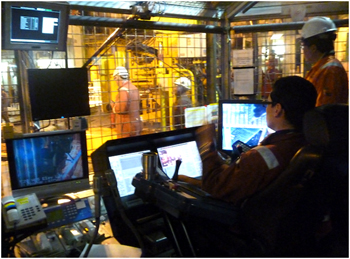
Driller’s house where operations are controlled on the rig floor.
The start of drilling was rather anticlimactic and quite slow over the first few tens of meters. Although, it was a relief when we received confirmation that logging data were being received from tools on the drill string. It is impressive that signals from the instruments near the drill bit can be sent through 7 kilometers of mud and water by acoustic pulses. This telemetry system had never been used before over such a long distance.
We were collecting data! A long three weeks of mostly waiting onboard the ship and an even longer year’s work by so many people in preparation for the JFAST project, and now the first borehole was really started and we were on out way to the fault !
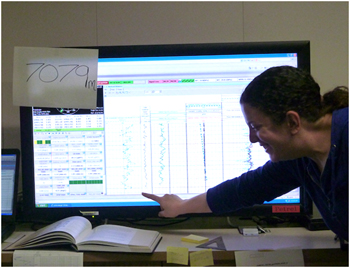
Monica Wolfson in front of monitor which displays logging data. 7079 m is the record breaking depth, as recorded at the rig floor, which 28.5 m above the sea level.
New World Record
Not only did we start collecting data for Expedition 343, we also set a new record in the process. Around 8:30 the next morning, Monica Wolfson, a morning shift watchdog, came by to say that the drilling was approaching the eagerly anticipated depth of 7049.5 meters below the sea surface. This depth represented the previous greatest total depth below sea level for any scientific ocean drilling project, and we were about to break that record. Colored data points appeared on the logging monitor, indicating that the drill bit was passing 7049.5 meters. Jim Sample popped open a precious can of Coke and carefully portioned it out into 15 small paper cups for a toast to the historic occasion.
Drilling continued through the night to a depth of 7308 meters below the sea surface (424 meters below the seafloor with a water depth of 6883.54 meters). Previously, the deepest penetration below the sea surface, as mentioned above, was 7049.5 meters during Deep Sea Drilling Program (DSDP) Leg 60 to the Marianas Trench in 1978. The DSDP borehole was drilled 15.5 meters below the seafloor in a water depth of 7034 meters.
From a birthday party to a wished for data collection, and from a long anticipated drilling start to a new world record, it was a couple of exciting days on the D/V Chikyu.
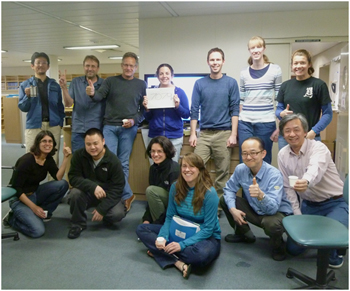
Breaking the depth record for scientific drilling.

















